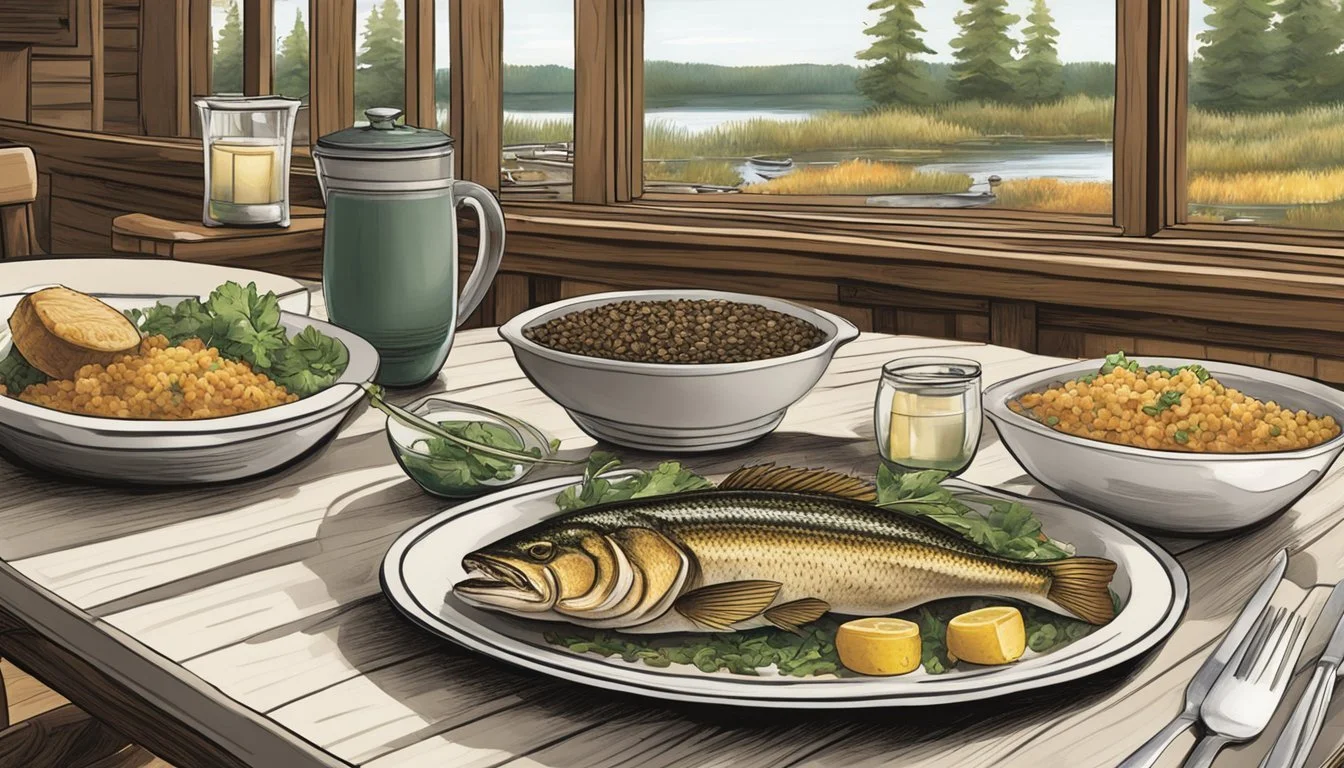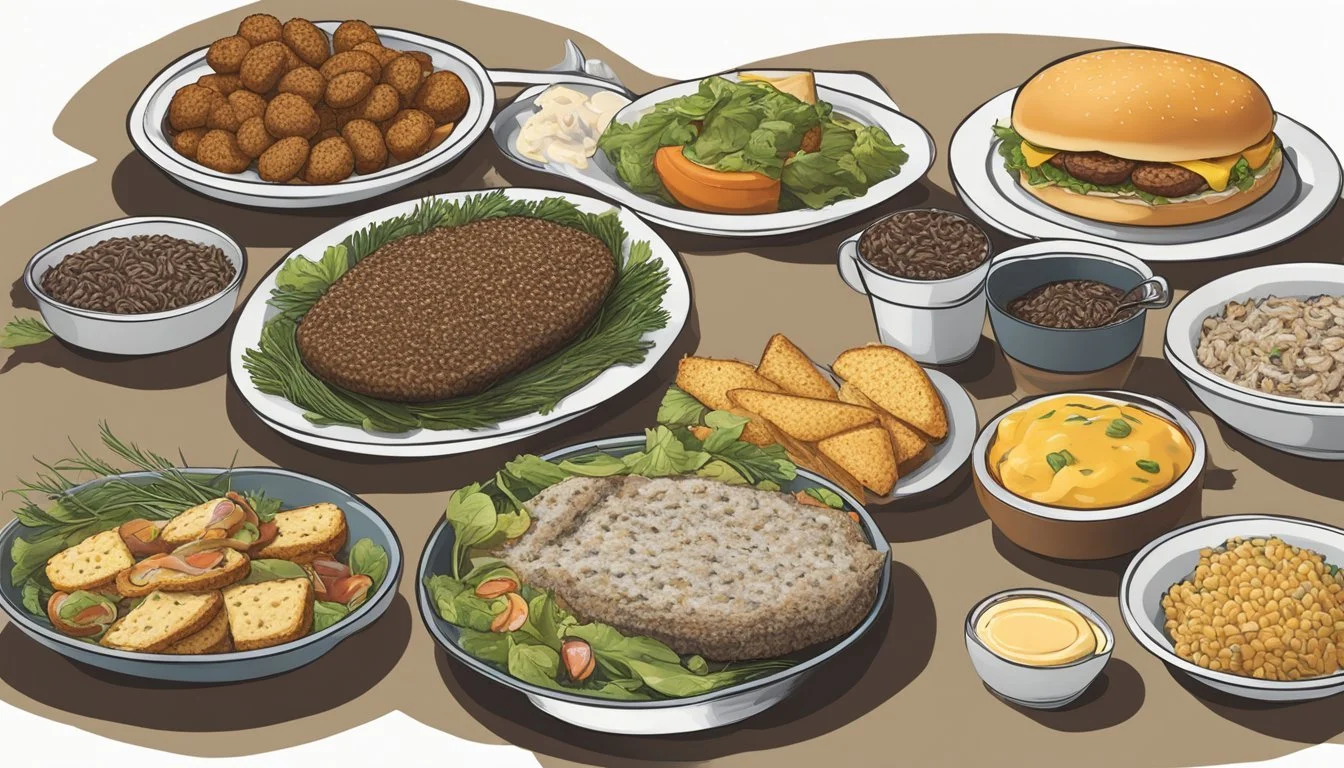What Food Is Minnesota Known For?
Exploring the State's Signature Dishes
Minnesota's culinary landscape reflects its unique history and cultural tapestry, with a diverse range of dishes that residents cherish and visitors seek out. Known for its natural abundance, particularly in the form of lakes teeming with fish, Minnesota's traditional cuisine includes the regionally iconic walleye. This freshwater fish is a staple on menus throughout the state, often prepared baked or fried, and revered for its light, flaky texture.
Aside from its aquatic offerings, Minnesota is also famous for wild rice (how long does wild rice last?), which, despite its name, isn't rice at all. It's a grain-like seed harvested from certain species of grass that thrive in the state's myriad lakes and rivers. This wild rice holds a place of pride in Minnesotan cuisine, historically gathered by Native Americans and continuing to be a versatile ingredient in everything from soups to salads.
Another quintessential dish synonymous with Minnesotan hospitality and comfort is the hotdish. This one-pan wonder, which typically combines a protein, starch, and vegetables all bound together with a creamy soup, is a fixture at family gatherings and community potlucks. The hotdish's simplicity and heartiness embody the spirit of Minnesota's home-cooking traditions.
Historical Background and Influences
Minnesota’s culinary landscape is deeply intertwined with its cultural history, reflecting contributions from Native American traditions and a mosaic of immigrant influences.
Native American Impact
The Dakota, the indigenous people of Minnesota, have had a profound influence on Minnesotan cuisine, particularly with the use of wild rice. Known as "manoomin" in the Ojibwe language, wild rice is actually a grain-like seed of marsh grass and is a staple in Native American diets. The harvesting of this wild rice is a long-standing tradition that continues to influence local culinary practices today.
Immigrant Contributions
Minnesota also has a rich heritage of Scandinavian and German immigrants who infused their culinary traditions into the state's food culture. Scandinavians brought with them dishes like lefse and lutefisk, complementing the existing indigenous foods. Similarly, German immigrants contributed their hearty cooking styles, which have been integrated into the framework of Minnesotan cuisine. These immigrant groups, along with others who settled in the region, played a significant role in creating the diverse food tapestry that Minnesota is famous for today.
Traditional Minnesotan Dishes
Minnesota's culinary scene reflects its cultural heritage and resources. From the state's Scandinavian roots to the innovative use of native grains, these dishes offer a unique taste of the North Star State.
Wild Rice Specialties
Wild rice, not to be confused with the typical varieties of rice, is a grain-like seed integral to Minnesotan cuisine. Harvested from local lakes and rivers, this native ingredient features prominently in Wild Rice Soup, a hearty and savory delight often prepared with vegetables, chicken, or wild mushrooms, offering warmth during the cold winters.
Scandinavian-inspired Delicacies
A nod to the state's Nordic heritage, Lefse is a must-try. This soft, Norwegian flatbread is made with flour and often includes riced potatoes, butter, milk, or cream. It's versatile and typically enjoyed with sweet or savory toppings. Swedish Meatballs, another classic, are seasoned with spices, served with gravy, and often accompanied by lingonberry sauce. Meanwhile, Lutefisk, a dish of dried whitefish rehydrated through a lye process, is a traditional holiday meal for those of Scandinavian descent.
Hotdishes and Casseroles
Minnesotans take pride in their Hotdish, a one-dish casserole that is a staple at community gatherings. The quintessential Tater Tot Hotdish consists of a creamy mixture of ground meat and vegetables, all topped with a crispy layer of tater tots. Other varieties may include Pasty, a meat and vegetable-filled pastry, borrowed from Cornish miners and adapted to the Minnesotan palate. Each hotdish offers a comforting experience that epitomizes the simplicity and communal spirit of the state's food traditions.
Modern Cuisine and Restaurants
The Twin Cities of Minneapolis and St. Paul are at the heart of Minnesota's dining scene, showcasing a rich blend of traditional comforts and innovative blends spearheaded by a diverse culinary community.
Famous Twin Cities Eateries
In the Twin Cities, 5-8 Club and Hell’s Kitchen stand as culinary landmarks. The former is renowned for its claim to the original Juicy Lucy, a cheese-stuffed burger that has become synonymous with Minneapolis. Downtown, Hell’s Kitchen offers unique takes on American cuisine, featuring items like homemade peanut butter (how long does peanut butter last?) and a roster of hearty breakfast items that attract both locals and visitors alike.
Local Comfort Foods
Comfort food in Minnesota goes beyond the generic with regional specialties like cheese curds, known for their delightful squeak when fresh. Pasties, originally Cornish but adopted by Minnesotans, are savory hand pies that satisfy hunger with a variety of fillings. These dishes embody the state's emphasis on hearty, satisfying meals fit to endure the chilly winters.
Fusion and Immigrant Cuisines
The Twin Cities have a vibrant tapestry of global cuisines with a particular highlight on Hmong sausage and Pho, a testament to the strong Vietnamese and Hmong communities in the region. These dishes can be found in local markets and eateries throughout St. Paul and Minneapolis, illustrating the rich fusion of immigrant traditions with Midwestern hospitality.
State Fair and Seasonal Foods
The Minnesota State Fair is an annual festival notorious for its eclectic array of indulgent foods, while the state's varied climate lends itself to a selection of distinctive seasonal produce and regional dishes.
Minnesota State Fair Favorites
At the Minnesota State Fair, food enthusiasts can find an incredible variety of dishes that range from quirky treats on a stick to classic favorites. Noteworthy among these is the Giant Egg Roll on a Stick, offered at Que Viet Concessions. Another staple is the Corn Roast, where butter-glazed, Minnesota-raised sweet corn becomes a highlight for numerous visitors. For those with a sweet tooth, the oversized peaches served with or without toppings remain a succulent choice, celebrated for their freshness and sourced from regions known for their quality produce, including Washington and Colorado.
Giant Egg Roll on a Stick at Que Viet Concessions
Butter-Glazed Sweet Corn at the Corn Roast
Fresh Peaches, Naked or with Toppings
Seasonal Produce and Dishes
Outside the time-honored fairgrounds, one finds the seasonal rhythms of Minnesota's produce influencing local palates. The state prides itself on the Honeycrisp Apple, a crisp and juicy variety developed at the University of Minnesota. During the autumn months, the state's pumpkin patches become a source for all things spiced and warming, including the popular pumpkin pie. In the spring, fish fries featuring local catches are common, coinciding with the fish spawning seasons. As the days grow colder, comfort foods such as cream of mushroom soup and Minnesota wild rice soup become staples. The blueberry season, short and sweet, brings forward the much-loved blueberry pie, harnessing the berry's tartness and vibrant flavor.
Spring: Fish Fry with Local Catches
Fall: Pumpkin Pie made from local pumpkins; Cream of Mushroom Soup with wild rice
Summer: Honeycrisp Apples; Blueberry Pie using seasonal blueberries (how long do blueberries last?)
Devotees of the Minnesota State Fair and seasonal dishes cherish these offerings, making them a central part of the state's food identity.
Regional Produce and Ingredients
Minnesota's natural bounty plays a vital role in shaping its culinary landscape. The state's lakes and fisheries provide a wealth of fish, while its farms and orchards yield a variety of fruits and vegetables. Local starches, such as the revered wild rice, are integral to Minnesota's gastronomy.
Lakes and Fisheries
Fish is a staple in Minnesota, which is known as the "Land of 10,000 Lakes." These bodies of water, abundant in fresh options, position walleye as a local favorite. Not only is it a popular catch for recreational fishing, but also a featured delicacy served in various styles across the state.
Walleye: Often pan-fried, grilled, or baked and served in sandwiches or as a main with sides
Other Fish: Wide variety includes trout, pike, and bass
Farms and Orchards
Minnesota's farms and orchards are celebrated for generating a high-quality selection of meats and produce. Beef and pork are major meat products, supported by the state's agricultural operations. Additionally, the state is renowned for its Honeycrisp apples (how long do apples last?), developed by the University of Minnesota and beloved for their crisp texture and balanced taste.
Meat: Includes a range of beef and pork cuts for local dishes
Fruit: Orchards produce apples like the Honeycrisp, as well as a bounty of blueberries during the summer.
Local Starches and Vegetables
The state grain of Minnesota, wild rice, holds cultural significance and is a staple in local cuisine. It's a versatile ingredient featured in traditional dishes like soups and hotdish. Vegetables such as corn and carrots are commonly grown and incorporated into Minnesotan diets. These ingredients reflect the state's agricultural diversity and rich culinary traditions.
Wild Rice: Integral to the state's culinary identity, found in soups and as a side
Vegetables:
Corn: An essential summer crop, often enjoyed fresh, grilled or as part of salads or salsas
Carrots: Commonly used in stews, casseroles, and side dishes
Food Culture and Identity
Minnesota’s food culture is deeply intertwined with its diverse communities, regional specialties, and rich agricultural heritage. This section explores significant locations that have shaped the local palate, as well as the distinctive flavors and dishes that constitute the state’s culinary identity.
Iconic Food Establishments
Minnesota boasts a variety of restaurants and food establishments that encapsulate the state's rich gastronomic tapestry. Within the bustling food scene, certain eateries stand as landmarks of cultural expression and tradition. For instance, Norsland Lefse in Rushford offers an authentic taste of the state's Norwegian influences through its specialty in lefse, showcasing the impact of immigrant populations on Minnesota's cuisine.
Breweries and distilleries also reflect Minnesota's penchant for craft and innovation, with local craft beers holding a significant place in social and dining experiences. The University of Minnesota has contributed to this sector through initiatives in agricultural research, helping to support local growers and producers of ingredients such as hops and grains.
Minnesota's Culinary Identity
The identity of Minnesota's cuisine can be characterized by the abundance of its natural resources and the ingenuity of its residents. Wild rice, officially recognized as the state grain, features prominently in local dishes, symbolizing the connection between Minnesotans and their environment. The Iron Range region, with its specific cultural influences, has also informed the state’s food offerings with dishes that resonate with the heritage of its communities.
Iconic foods extend beyond wild rice to include creative fair favorites such as Pronto Pups and deep-fried candy bars, which are culinary staples at the Minnesota State Fair. These items, served "on a stick," represent a playful and inventive aspect of the state's food scene, while remaining a celebration of the local penchant for communal gathering and festivity.
Dietary Trends and Health Considerations
Minnesota's food scene reflects both historic preferences and modern health conscious trends. This shift is evident in the growing popularity of organic and farm-to-table food movements as well as an increased availability of vegetarian and vegan options.
Organic and Farm-to-Table Movements
The organic movement in Minnesota emphasizes fresh, locally sourced ingredients, often found at farmer's markets or through CSA (Community Supported Agriculture) programs. Food items like vegetables, including the state's beloved Honeycrisp apples, and hazelnuts are common organic products. Farm-to-table restaurants and initiatives encourage sustainable agricultural practices and directly support local farmers.
Local Farms: Consumers support local agriculture by purchasing directly from farms.
Seasonal Menus: Restaurants incorporate seasonal items, such as Honeycrisp apples, into their menus.
Organic Labeling: Consumers seek out organically certified goods at grocery stores and markets.
Vegetarian and Vegan Options
The landscape of vegetarian and vegan options in Minnesota is expanding, with restaurants and food manufacturers introducing plant-based alternatives to cater to this dietary preference. Vegetables and grains are central to these diets, while innovative dishes reimagine tater tots and chicken as plant-based delights.
Vegetarian Restaurants: These establishments offer diverse menus, from casual to fine dining.
Supermarkets: Plant-based product sections, including mock meats and dairy alternatives, have grown.
Food Festivals: Events dedicated to vegetarian and vegan lifestyles showcase new products and cooking methods.
Desserts and Sweets
Minnesota's dessert scene is a delightful blend of classic treats rooted in cultural heritage and modern sweets that draw crowds. Here, cherished recipes are passed through generations, and innovative creations gain rapid popularity on Instagram, reflecting the state's gastronomic diversity.
Traditional Treats
Minnesota takes pride in its Bundt Cake, a dessert so entrenched in state culture that it is a testament to Minnesota's culinary tradition. The Bundt Cake's distinctive ring shape and variety of flavors make it a staple in Minnesotan homes, often serving as a symbol of hospitality during gatherings.
Another heritage dessert is the Kolache, a pastry with origins in Central Europe, traditionally filled with fruits like blueberries or raspberries. Minnesota's festive occasions often feature these fruit-filled delights, showcasing the state's penchant for incorporating local produce into their baking.
Contemporary Delights
Seekers of contemporary treats will find the Minnesota dessert landscape speckled with creations like Honeycrisp Apple-infused delicacies. Developed by the University of Minnesota, this apple variety lends its crisp texture and subtle sweetness to pies and turnovers, finding its way onto social media feeds for its eye-catching appeal.
In the realm of contemporary sweets, chocolate chip cookies offer a universally beloved treat. Minnesota bakers put their unique spin on this classic cookie, continuously refining their recipes to achieve a balance of gooey, chewy, and crisp textures that locals and visitors alike find irresistible.
Beverages and Libations
Minnesota's beverages reflect its rich cultural heritage and resourceful spirit. From the cherished breweries that dot its landscape to the innovative local distilleries and the cherished non-alcoholic options that mirror the state's agricultural bounty, there's a drink for every taste and occasion.
Breweries and Beer Culture
Minnesota is home to a thriving beer scene, characterized by an array of breweries that cater to every preference, from traditional lagers to bold craft ales. The state's beer culture is a fabric woven of community and innovation, with August Schell Brewing Company standing as one of the oldest, while breweries like Surly Brewing Co. represent the modern craft movement. Patrons often enjoy pairings with local foods such as the Juicy Lucy, a cheese-stuffed burger that has become a Twin Cities hallmark.
Local Distilleries and Spirits
The state's distilleries contribute to Minnesota's libations with a range of local spirits, highlighting ingredients such as the Honeycrisp apple, a beloved development from the University of Minnesota. They offer a selection that includes whiskey, vodka, and other spirits infused with a sense of place. Du Nord Craft Spirits and Tattersall Distilling are notable examples, often utilizing local grains and botanicals.
Non-Alcoholic Specialties
For those who prefer non-alcoholic options, Minnesota's offerings are just as rich. The state's Swedish heritage shines through in Fika, a coffee break that includes more than just coffee, often featuring pastries enriched with the tart pop of lingonberries. Additionally, the Cream of Mushroom soup has found a non-alcoholic niche as a cooking staple, often included in Minnesota's iconic hotdish recipes.











